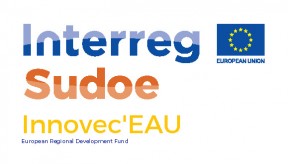
Innovec'EAU
Drug residues in discharges from old people's homes (EHPAD and elderly people residential facilities) : Risks, innovative tools for analysis and sustainable treatment processes.

Axis 1 Research and innovation
Objective 1b1 Strengthening the synergic and networking operation of R+i at a transnational level in the specific Sudoe sectors as from smart specialisationImage gallery
- Water resources (technologies for an efficient management, potential development or economic activities, smart distribution systems, quality control, irrigation systems, supply, etc.)
- Environmental services (management and risk protection and biodiversity) and energy (production technologies, distribution and storage from renewable sources), air quality and emissions control
2. ISCTE - Instituto Universitário de Lisboa. PT
3. Université de Nîmes. CHROME EA 7352. FR
4. Universidad Complutense de Madrid. Sección Departamental de Psicología Social. ES
5. Instituto Pedro Nunes. Laboratório Eletroanálise e corrosão PT
6. Agencia Estatal Consejo Superior de Investigaciones Científicas. Instituto de Diagnóstico Ambiental y Estudios del Agua. ES
7. Institut National Polytechnique de Toulouse. Laboratoire de Génie Chimique UMR INP-UPS-CNRS 5503. FR
8. DropSens, S.L. FR
Project summary
The avoidance of water pollution is one of the main challenges of south-west European countries. Although current legislation obliges administrations to control their "priority pollutants", supervision programmes have detected the diffuse and persistent pollution of "emerging" pollutants which are not affected by traditional purification treatments. The objective of this project is the carrying out of a study on the dumping of wastewater from old people's homes in south-west Europe so as to install technologies for the treatment and follow-up of drugs.
Participating regions
- Cataluña
- Centro
- Comunidad de Madrid
- Languedoc-Roussillon
- Lisboa
- Midi-Pyrénées
- Principado de Asturias
Estado de avance del proyecto
INNOVEC’EAU responds to the European Commission Framework Directive on the monitoring of “priority pollutants”. Thus, the project carried out a transnational study on the substances expelled in the wastewater of nursing homes in the south-west of Europe and, consequently, developed a pilot project on innovative technologies for the treatment and monitoring of drug residues, taking into account the environmental dimensions , sociological and economic. The project is particularly new as part of the association of a physical-chemical procedure with a biological treatment procedure for optimal decontamination of wastewater that allowed the development of prototypes based on solar photo-oxidation reactors and a decontamination unit in based on a biological procedure and a photo-catalytic procedure. The project has also created an analysis instrument, based on electrochemical captors and bio-captors, for online and real-time monitoring of the degradation of pollutants.
The results of the project include:
- The characterization and comparison of wastewater from nursing homes to select a total of 12 pharmaceutical substances to analyse.
- The development of a treatment and control of wastewater before being rejected in the urban network of wastewater.
- The analysis of the perception of the populations and actions of communication and sensitization to the problem of the contamination of the waters by pharmaceutical substances. Among these, some video clips and informational scripts were made.







